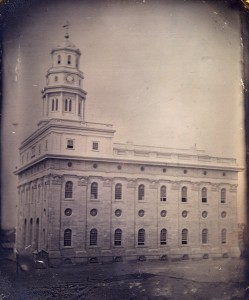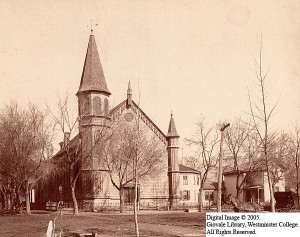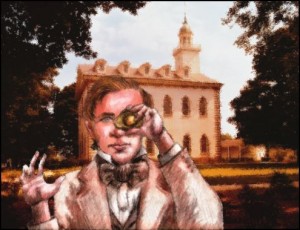Robert Millet, professor of education at Brigham Young University, has contributed an article to the Washington Post addressing the question, “Are Mormons Christian?” As part of his apologetic published on June 4 (2012) Dr. Millet wrote,
“So far as I can determine, the cry of ‘Mormons are not Christian’ was not heard very often during the formative period of Mormon history. Baptists and Methodists and Presbyterians in the area knew that the followers of Joseph Smith believed in doctrinal matters that deviated somewhat from traditional Christianity. Folks seemed to assume, however, that Mormonism fit under the umbrella of Christianity.”
Dr. Millet’s determination may or may not be correct, but for the sake of discussion, I would like to explore the idea that Christians during the “formative period” of Mormon history believed Mormonism “fit under the umbrella of Christianity.”
In the introduction of Kurt Widmer’s book, Mormonism and the Nature of God: A Theological Evolution, 1830-1915, Widmer writes,
“While the early Mormon Church of the 1830s was not significantly distinct from the rest of 19th-century Christianity, later Mormonism became quite distinct from the rest of 19th-century Christendom. For nearly a century, the Church underwent changes in its beliefs. The best example of these changes is seen in the development of the Mormon concept of God.” (4. Except where otherwise noted, all page numbers in the following article refer to Widmer’s Mormonism and the Nature of God, McFarland & Company, 2000.)
Furthermore,
“Converts to early Mormonism…did not join the Church because of the doctrines that were taught.
“As James Allen has outlined, early converts would not have had to alter their theology in order to join the Church. If belief in the Book of Mormon was a pre-requisite to joining the Church, it was a belief in the book’s divine origin rather than in the doctrinal content of the book. The Book of Mormon taught nothing different from what early 19th-century religious seekers would have already been familiar with.
“The theology of the Book of Mormon was monotheistic. Early Mormon theology then would not have been unique in comparison to other beliefs of the day.” (20)
Widmer notes that early on, Joseph Smith mainly used biblical texts for “sermons and doctrinal exposition,” and used the Book of Mormon “sparingly,” suggesting that “Smith’s theological convictions were rooted in the biblical literalism of the day” (27).
In his essay, “The Earliest Mormon Concept of God,” Dan Vogel notes that due to the “ambiguity” of the founding document of the Mormon Church (“Articles and Covenants,” June 1830) “many outsiders concluded that the Mormon view of God was similar to orthodox Trinitarian creeds” (Line Upon Line, 17).
But Mormonism was changing. Vogel writes, “Various scholars have noticed a shift in the Mormon concept of God in the mid-1830s” (Line Upon Line, 26). Referencing the “Lectures on Faith” that were included in the Doctrine and Covenants from 1835-1921 Vogel writes, “…this description of the Godhead represents a shift to binitariansim.” Then,
“When Joseph Smith was preparing to publish a second edition of the Book of Mormon in 1837, he revised several passages to reflect this new understanding of the Godhead… By the 1840s the Mormon concept of the Godhead had developed to a clearly defined tritheistic (literally, ‘three gods’) position” (Line Upon Line, 27).
 Little by little the theology of Mormonism shifted away from what initially appeared to be familiar Christian theology. In April 1844 Joseph Smith preached the King Follett Discourse in which he taught radical ideas about God. These teachings included that God the Father had once been a man, who lived on another earth, who progressed to Godhood, who was but one of a council of Gods, who invites human beings to become Gods like himself. Even some of Joseph Smith’s followers found the sermon troubling. In Kurt Widmer’s opinion, it was the teachings in the King Follett Discourse that led directly to the publication of the dissenting newspaper, the Nauvoo Expositor — which Joseph Smith quickly condemned and destroyed.
Little by little the theology of Mormonism shifted away from what initially appeared to be familiar Christian theology. In April 1844 Joseph Smith preached the King Follett Discourse in which he taught radical ideas about God. These teachings included that God the Father had once been a man, who lived on another earth, who progressed to Godhood, who was but one of a council of Gods, who invites human beings to become Gods like himself. Even some of Joseph Smith’s followers found the sermon troubling. In Kurt Widmer’s opinion, it was the teachings in the King Follett Discourse that led directly to the publication of the dissenting newspaper, the Nauvoo Expositor — which Joseph Smith quickly condemned and destroyed.
“Through the pages of the Nauvoo Expositor the Nauvoo dissenters… made their disaffection with the Prophet known. Among the key points of disagreement with the Prophet were the very concepts that Joseph had taught in April of that year, that a hierarchical Council of Gods existed and that men could become Gods.” (Mormonism and the Nature of God, 14-15)
Joseph Smith died before he could fully develop this new theology. Widmer writes,
“’Hence, with only a single sermon from which to start, the Mormon leadership would need to expand upon that and provide a clear exposition on the nature and character of God. It would be during the Salt Lake period that the origin and destiny of God, and therefore man, would be dealt with.” (129)
After the death of Joseph Smith, the Mormons moved west under the leadership of Brigham Young — where Young introduced, among other things, a new theology that declared Adam (who was in the Garden of Eden) was God. According to Widmer, “The Adam-God doctrine appears to have been the dominant Mormon theological position on the godhead during the latter half of the 19th century” (131).
 In 1877 the Rev. R.G. McNiece became the pastor of First Presbyterian Church in Salt Lake City, Utah. Twenty years later, after having “the opportunity to secure complete understanding of the system” of Mormonism, having spent a generation listening to Mormon leaders, and studying Mormon books, pamphlets and articles, R.G. McNiece concluded, “Christian people everywhere need to have a clear idea of what Mormonism really is, and the shameful way in which it dishonors the Bible and the Christian religion” (Mormonism: Its Origin, Characteristics and Doctrines). In his writings, Rev. McNiece makes it very clear that Mormonism does not fit under the umbrella of Christianity. Calling Mormonism “anti-Christianity” and “a deliberate counterfeit of the Christian religion,” he says it is a “reproach on the Christian churches of this country that, after eighty years, such a system of downright heathenism should still hold the people of one of the great states of the West in absolute bondage.”
In 1877 the Rev. R.G. McNiece became the pastor of First Presbyterian Church in Salt Lake City, Utah. Twenty years later, after having “the opportunity to secure complete understanding of the system” of Mormonism, having spent a generation listening to Mormon leaders, and studying Mormon books, pamphlets and articles, R.G. McNiece concluded, “Christian people everywhere need to have a clear idea of what Mormonism really is, and the shameful way in which it dishonors the Bible and the Christian religion” (Mormonism: Its Origin, Characteristics and Doctrines). In his writings, Rev. McNiece makes it very clear that Mormonism does not fit under the umbrella of Christianity. Calling Mormonism “anti-Christianity” and “a deliberate counterfeit of the Christian religion,” he says it is a “reproach on the Christian churches of this country that, after eighty years, such a system of downright heathenism should still hold the people of one of the great states of the West in absolute bondage.”
I posit that if Robert Millet is correct that Christians believed “Mormonism fit under the umbrella of Christianity” in its “formative” years, it is because Mormonism had not yet embraced the radically heretical theology that has come to define the religion’s Godhead today. Therefore, I agree with Rev. McNiece,
“The one important thing to be done is to double the Christian missionary forces in Utah, in order to bring deliverance to those who are in bondage.”


Kudos Sharon! This article gave me a burning in the bosom. I assume, therefore, what you have written here is true.
This of course is my favorite subject when dealing with Mormonism; the evolving doctrine of the Mormon doctrine of the nature of God. In surfer dude lingo, Joseph Smith caught a wave in Nauvoo and Mormonism has been riding it ever since. That wave was his joy, “inspiration” and just plain fun in religious speculation and creativity.
That reflects the era in which Mormonism grew. Not only was it a time of great evangelical revivalism but it was also a time of religious/spiritual speculation. There were all kinds of thoughts floating through the environment in the area that Smith called home. One such thought was that the Indians were a lost tribe of Hebrews. I think I’m quoting Grant Palmer right when he said that when it came to the BoM, for example, Smith got 25% from the Bible, 25% of evangelical Christian revivalism, 25% from his own creativity and the last 25% from ideas that “were in the air”, “in the environment”. I would guess this would include the book “A View of the Hebrews”.
Mormonism has something called “progressive revelation” which means that you can change basic doctrine, walk things back, reload and actually participate in vain speculation with no penalty or sanction. It just means the prophet just got a new revelation and isn’t it exciting?
No, Mormonism left the Christian mold when Smith caught his wave. It’s been a thrill packed ride for Mormonism ever since.
Narly Dude!
Prof. Millet closes his Washington Post article with this statement: ” There is too much at
stake in the world for God-fearing people to spend their time attacking one another.”
I agree. ( It would be nice to know exactly what he means by the term , “attacking” )
I’m wondering if he also had in mind some of his leadership when he stated , “one another ” ?
Are they innocent of any attacking ?
Yea Mike,
That is an interesting comment. As has been pointed out numerous times on this blog, the whole point of Mormonism in its formative years was to attack Christianity. Even that little play they use to do in the temple showed the devil seducing the Christian preacher. I believe that modern era Mormons thought better of it and dropped that portion of the drama.
Also, pointing out how Mormonism deviates from normative Christianity is not an attack. Would that Mormons were so up front regarding their “unique” doctrine that they would be straight forward regarding what they believe.
I guess that with all of the fits and starts and zigs and zags in Mormonism that the Mormon god didn’t see fit to give Joseph Smith and subsequent Mormons the full restored gospel. As it is, the Mormon god seems to have given the Mormon prophets some trial balloons and then later shoot them out of the air.
Mormonism is a man-made religion not based on Scripture and certainly not divine revelation.
Falcon, I think that since Prof. Millet is employed by the Church then we can’t really expect
the whole truth about any given subject from him . But since he seems to being saying that
the “formative period” of Mormon history was in the 1830’s or so , then I wonder what he
would term the period under the next several Mormon prophets in Utah ? This period saw
Mormon leaders engage in some very clear attacks in teaching about other churches , this
issue seems to be excluded when notable Mormons give public interviews etc. For some
sincere Mormons when told that Mormonism “deviates ” from Traditional Christianity that
might not mean much to them , but these same Mormons need to realize that Mormon leaders
have also “deviated” from their own past colleagues . Mormon leaders have promised to never
advance false doctrine , and to offer the remedy for what is said to plague all other churches :
a pattern of unstable / altered doctrine . These “modern-day apostles ” claim to be guides in
spiritual truth, the sole authorized channel of communication from which God revealed the
gospel, a “restored gospel ” in 1830. Unfortunately much what Mormon apostles have taught as
gospel truths since that time is not Jesus’ original gospel restored BUT Jesus’ gospel replaced
since Mormon authorities have added their own ideas created in their own hearts and
then taught these as part of the ” restored gospel ” . This behavior is not new —- 2 Jn 9
Jer 23 :16 ; (Alma 28:14,31) . The Mormon people deserve more trustworthy apostles–Rev2:2
By the 1840’s Joseph Smith was revealing many new spiritual truths , ” line upon line ” as
Mormons describe it . Some new truths about God that he publically taught were not fully
articulated due to his untimely death . Sharon cites author Kurt Widmer as he describes
this time : ” Hence with only a single sermon from which to start , the Mormon leadership
would need to expand upon that and provide a clear exposition on the nature and character
of God. It would be during the Salt Lake period that the origin and destiny of God , and
therefore man, would be dealt with.” Brigham Young understood this and proceeded to
fulfill his calling to carry on for his mentor . One example of this doctrinal progression was
that polygamy was clearly acknowledged and taught publically by Pres. Young in Utah .
Spiritual truths about God that were elaborated on and publically taught in Utah were :
There is a Heavenly Grandfather ; there is a Heavenly Mother ; Heavenly Father is a
polygamist; He has white skin; the three creation Gods were Elohim, Jehovah, and Michael ;
Adam was the God who sired Jesus and all the other spirits ; Adam was a polygamist;
Adam came to this earth from another earth.
Have any of these doctrines been mentioned in General Conf , BYU firesides, or church
curriculum lately ? Why Not ? Brigham Young , setting the bar for all prophets who would
succeed him stated that it was his duty to teach accurate doctrine and make sure others in
leadership did also thus reassuring his flock of spiritual safety. Did he? Rev2:2
At Church today a baby was baptized. I won’t get into the theology for or against that practice (I can go either way) but we recited the Apostle’s Creed. The pastor prefaced the recitation by saying that the creed was not Scripture. He explained the creed was a way that the early church used to clearly articulate basic doctrine and to identify heresy.
Now Mormons get all wound up over “creeds” however have they ever stopped to consider that the creeds are really “revelation”? I’ve also pointed out previously that Mormons need to think of the various councils that occurred up to about 400 AD as “general conference”. OK, that last part is somewhat tongue in cheek. However the creeds do reflect the revelation of Jesus Christ as articulated in Scripture.
Notice that the main elements of Christianity haven’t changed.
Mormon doctrine has changed significantly since it’s inception and the various sects of Mormonism have significant differences relative to very basic (doctrines) such as the nature of God.
Really what Mormons need to consider is, “Who is God?” Answering that one question correctly will set them on the pathway to eternal life, if they answer it correctly.